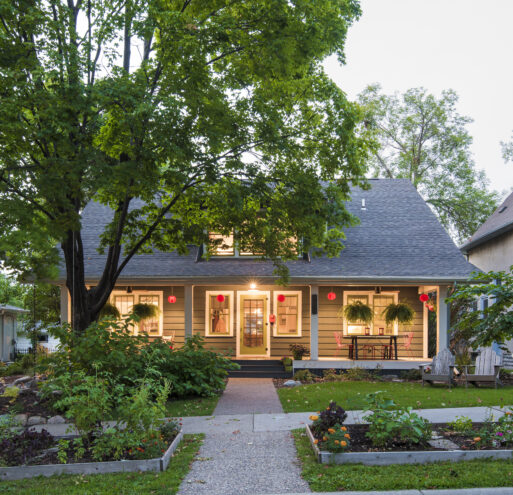
5 Ways to Embrace the Darkness
The awareness of light is anchored by darkness.
– Max Jacobson, The Good House
As we pass through the Winter Solstice, one can’t help but notice the lack of light. In Minnesota, where we live and practice, the darkness of winter is hard to ignore – we have only 8 hours of daylight on the shortest day of the year. With most humans spending 90% of their time indoors, daylight, or lack thereof, shares an important relationship with architecture and the built environment (Evans & McCoy, 1998). Because of the sheer volume of time most of us spend indoors, designers have been searching for strategies to reconnect us to nature.
Biophilia is a trending design term, rooted in Edward Wilson’s seminal 1984 book aptly titled Biophilia which refers to the human drive to connect with nature and its processes. Biophilic design strategies involve using elements from the environment throughout interior spaces to connect users to the natural world through patterns and processes found in nature. Natural light, filtered light, light and shadow, light pools, reflected light, warm light, and light as shape and form are all ways in which we can use light (and darkness) when designing a space (Keller, Heerwagen, and Mador). Architects, designers, and homeowners can explore a plethora of design strategies that respond to our innate relationship to natural light, shadow, and darkness when creating a space. There are a myriad of approaches, perspectives, and cultural interpretations around this topic. Here we’ll scratch the surface on a few of the many methods to embrace this contrast between light and dark and in doing so create a deeper connection to nature.
#1 – Create contrast between inside and out
In Minnesota, the spring and fall provide abundant gray-blue, overcast days. Using a darker material palette on the interior creates contrast with the pale sky and Midwest landscape on the exterior. Strategically creating a dark interior to contrast the winter (or more importantly shoulder season) exterior, often results in a cozy space and a deeper connection to the landscape and seasons.
Left: Writer’s Cabin by Pfeffer Torode. Nashville, TN 2016. Photograph by Nick McGinn.
Right: UNCAGE by Takanori Ineyama Architects and Okayama Prefecture Architectural Design Firm. Yamagufu City, Japan, 2023. Photo by Koichi Fujimura.
#2 – Use shadow to your advantage
Deep overhangs can create voluminous shadows, help with energy bills in warmer months, and shed water away from a building’s foundation. On the interior, shadows create curiosity and enticement by drawing us into the unknown.
Serpentine Gallery Pavilion by Peter Zumthor. London, England 2011. Photo by John Offenbach.
Serpentine Gallery Pavilion by Peter Zumthor. London, England, 2011. Photo by Walter Herfst.
#3 – Contrast light with material darkness
Using dark cladding on the exterior of a building can highlight the contrast between the building and the sky while also blending it into the landscape. Forests appear black in winter so the thoughtful use of exterior and interior lighting creates strong contrast and illuminates the building so that it can be enjoyed when the sun is down.
Black Gables by Omar Gandhi. Louisdale, Canada, 2014. Photo by Greg Richardson.
Flower Valley Homestead by Shelter Architecture. Redwing, MN, 2023. Photo by Farm Kid Studio.
Writer’s Cabin by Pfeffer Torode. Nashville, TN 2016. Photo by Nick McGinn.
#5 – Make light a destination
Use a skylight or clerestory window to top light a room or area within a darker volume of space to create drama and a connection to the sky.
Left: Space T2 by Steven Holl Architects. Rhinebeck, NY, 2016. Photo by Pfeffer Torode.
Right: Fjord Boat House by Norm Architects and Arkitema. Denmark, 2020.
#5 – Respond to the seasons
Take advantage of winter and reduced daylight by designing a space that takes full advantage of the sun moving across the southern sky. Doing so will invite the cool pastels of winter light inside which can then be warmed up using warm, glowy light fixtures, a fireplace, or candles.
Rothaus by Jonathan Tuckey Design. Andermatt, Switzerland.
Design with darkness
In the quest to reconnect with nature and create spaces that resonate with our innate relationship to light and darkness, embracing the contrast between the two feels more important than ever in these long, cold winter months. By implementing strategies that intentionally respond to seasonality and light and dark, designers and homeowners can forge this deeper connection to nature. Spaces that embrace the possibility that darkness offers and celebrate the interplay between sunshine and shadow allows us to appreciate the beauty of the natural world through our contributions to the built environment.
Want to explore light (or darkness) in your space? Contact us. We’d love to chat.
Pin this post
Resources
Coburn, A., Vartanian, O., & Chatterjee, A. (2017). Buildings, beauty, and the brain: A neuroscience of architectural experience. Cognitive Neuroscience, 29(9), 1521-1531.
Evans, G. W., & McCoy, J. M. (1998). When buildings don’t work: The role of architecture in human health. Journal of Environmental Psychology, 18, 85-94.
Kellert, Heerwagen, and Mador. Biophilic Design (2013). The Theory, Science, and Practice of Bringing Buildings to Life.
Vessel, I. B. (2006, May-June). Perceptual Pleasure and the Brain. American Scientist, 94, pp. 248-255.
Wilson, E. O. (1984). Biophilia. Cambridge: Harvard University Press.
Related Posts
Custom kitchen serves chef’s needs
When a pair of empty-nesters came to Shelter to cook up plans for updating their longtime home, the kitchen was…
Read moreHome Tour highlights Shelter renovation project
When thousands of Twin Cities residents flock to the Minneapolis & Saint Paul Home Tour in April, their itinerary will include…
Read more
2018 BLEND Award – Best in Show – St. Paul
Shelter Architecture wins Best in Show-St. Paul for the 2018 BLEND Awards! The BLEND Award recognizes Architects, Builders, and Remodelers who…
Read more